Celestichthys erythromicron
SynonymsTop ↑
Microrasbora erythromicron Annandale, 1918; Danio erythromicron Annandale, 1918
Etymology
Celestichthys: from the Latin caelestis, meaning ‘heavenly’, and ichthys, meaning ‘fish’.
erythromicron: from the Ancient Greek ἐρυθρός (erythros), meaning ‘red’, and μικρόν (mikron), meaning ‘small’.
Classification
Order: Cypriniformes Family: Cyprinidae
Distribution
Known from the isolated mountain lake of Inlé and surrounding watershed in Shan state, eastern Myanmar, and also occurs close to Loi Kaw township in neighbouring Kayah state to the south.
Type locality is given simply as ‘Inlé Lake, Myanmar’.
Habitat
Lake Inlé lies in a karstic valley known as the Yawnghwe basin located almost 900m above sea level in the Shan Plateau region and is home to many endemic animals including nine species of fish and numerous gastropods.
It was originally much bigger and may originally have been more than 90 metres deeper than it is now.
The water in Lake Inle is clear, shallow (2-3 metres deep in most places) and has a very fertile, loamy substrate.
It’s famed for its stilted villages and local fishermen known as Intha who row their boats using only one leg.
These people, thought to have migrated from the south of Myanmar in the late 1300s, use naturally-occurring floating ‘islands’ consisting of tangles of various plant species as gardens.
These islands form a wide raft around the lake margins and the Intha take them as required, removing the aerial leaves and cutting them into sections.
Bamboo poles are added for support allowing fruit, vegetables, rice and flowers to be produced in commercial quantities.
The gardens rise and fall with the water level and have come to form the habitats of many fish which take shelter among the tangle of roots and plant stems at their base.
Macrophytes also grow densely in the crystal-clear water and include Ceratophyllum and Elodea-like species.
D. erythromicron is mostly collected around the margins of the lake where grass and reed-like plants proliferate and the floating islands form thick mats composed of both live and dead vegetation.
Impossible to catch with a net, fishermen use special traps placed among the plants overnight.
As the lake is situated in a karstic zone it contains neutral to slightly alkaline water with the pH value varying between 7.5 – 8.0.
Its main outlet is a seasonal stream known as the Balu Chaung which floods at certain times of year allowing the transfer of fishes to pools and ponds close to Loi Kaw.
During drier months these are disconnected, isolating small populations of several species.
We’ve yet to obtain detailed information regarding these habitats but expect them to be characterised by similarly sluggish, clear water with dense marginal and submerged plant growth.
Maximum Standard Length
Fully-grown at just 20 mm.
Aquarium SizeTop ↑
Despite its small size minimum base dimensions of 60 ∗ 30 cm are recommended due to the sometimes combative behaviour of dominant males (see ‘Behaviour and Compatibility’).
Maintenance
This timid species should ideally be kept in a heavily-planted set-up, preferably with a dark substrate.
The broken lines of sight that exist in such a display allow it to display natural behaviour as well as helping to reduce skittishness.
Floating plants are a useful addition but driftwood and oak/beech/almond leaf litter are best avoided as the tannins they release are not a feature of its natural waters.
Use gentle filtration; an air-powered sponge-style unit should prove adequate.
Water Conditions
Temperature: Temperatures in Lake Inle have been recorded to vary between 20 – 24 °C.
pH: 7.0 – 8.0. This species will not do well in acidic water.
Hardness: 215 – 357 ppm
Diet
Likely to feed on small invertebrates, algae and other zooplankton in nature.
In the aquarium it will accept dried foods of a suitable size but should not be fed these exclusively, and as it rarely rises to the surface there’s little point in offering floating products.
Daily meals of small live and frozen fare such as Daphnia, Artemia and suchlike will not only result in the best colouration but encourage the fish to come into breeding condition.
Newly-imported specimens are often in poor condition and can be difficult to acclimatise to aquarium life.
Small live foods are therefore recommended as an initial diet with dry and frozen products being introduced as the fish become settled.
Behaviour and CompatibilityTop ↑
Likely to be intimidated or outcompeted for food by larger or more boisterous tankmates although the presence of similarly-sized, surface-dwelling species seems to help reduce its shyness.
Other small cyprinids from Myanmar such as Celestichthys choprae or members of the genus Microdevario are suitable companions, and we suspect it might also do well alongside Dario hysginon or D. sp. ‘Myanmar’.
The closely-related C. margaritatus is not recommended as these two are probably capable of hybridisation.
A community based around fishes from Lake Inle would make an interesting project with species available in the trade including Sawbwa resplendens, Inlecypris auropurpureus, Microrasbora rubescens, Pethia stoliczkana, Parambassis lala and Yunnanilus brevis.
Though gregarious by nature it’s a shoaling rather than schooling species with rival males sparring on a regular basis during daylight hours.
It’s not uncommon to see nipped fins within a group though this behaviour does not normally extend to tankmates.
Buy as many as possible, ideally 20 or more, as when kept in larger groups the aggression is spread between individuals plus the fish are bolder, more often-seen, and exhibit better colouration.
Sexual Dimorphism
Adult females tend to grow slightly larger than males and be noticeably rounder in the belly, more so when gravid.
Males are more colourful, with well-defined, iridescent blue vertical bars on the flanks and red colouration in the fins.
Reproduction
Like many small cyprinids it’s an egg-scattering spawner that does not exhibit parental care.
If the fish are in good condition they will spawn often and in a densely-planted, mature aquarium it’s possible that small numbers of fry may start to appear without intervention.
However if you want to increase the yield of fry a slightly more controlled approach is required.
The adult group can still be conditioned together but one or more smaller, perhaps 10-15 litre, containers should also be set up and filled with aged water.
Fill much of the available space with fine wool mops, Taxiphyllum or other fine-leaved plant. Neither lighting nor filtration is necessary although you can install a small air-powered sponge filter if you prefer.
When the adult fish are well-conditioned a single pair or group comprising one or two males and several females can then be introduced to each container, though it’s worth noting that the more individuals involved the greater the risk of egg predation, plus males may distract each other from females if there’s more than one in the tank.
Spawning normally presents few problems with around 30 mildly adhesive eggs deposited in a typical event.
At this point the adults are best removed as they will eat any they find, plus females need a recovery period before spawning again as they’re unable to produce eggs on a daily basis.
In nature it apparently breeds year-round so you could always select another pair and work a rotation system if continuous production is the aim.
Incubation is temperature-dependant to an extent but usually takes around 72 hours with the young free-swimming 3-4 days later.
Initial food should be Paramecium or a proprietary dry food of sufficiently small (5-50 micron) grade, introducing Artemia nauplii, microworm, etc., once the fry are large enough to accept them.
NotesTop ↑
This species was formerly included in the genus Microrasbora although it’s long-been considered a danionin by certain authors, e.g., Kottelat and Witte (1999) and was placed within the genus Danio for a period.
In the aquarium trade it’s marketed under various names including ’emerald dwarf danio’, ‘thick band purple zebra danio’ and ‘cross-banded dwarf rasbora’.
There also exists limited evidence to suggest it’s been hybridised with the related C. margaritatus and the resulting offspring sold as females of the latter.
These fish have no stripes in the fins and a dark spot at the base of the caudal peduncle as in C. erythromicron, but spotted colour pattern on the body like C. margaritatus.
The small adult size evolved via a process known as miniaturisation, characterised by sexually mature adults with a significantly reduced size of less than 20 mm SL.
Among bony fishes cyprinids are one of the few groups in which this phenomenon occurs repeatedly with all Barboides, Danionella, Microdevario, Microrasbora, Horadandia, Boraras, Paedocypris, Sawbwa and Sundadanio species representing miniaturised taxa along with a few members of Danio, Laubuca and Rasbora.
All show a preference for still or slow-moving waters, often in nutrient-poor habitats such as forest peat swamps.
The anatomical structure of miniaturised cyprinids can vary greatly, and there are two principle ‘groupings’ with some species possessing intermediate features to some degree.
The first contains those fishes which though small are essentially proportionally dwarfed versions of their larger relatives, e.g., Barboides, Microdevario, Microrasbora, Horadandia, Boraras, Sawbwa, Sundadanio, Celestichthys, Laubuca and Rasbora.
The other includes those in which anatomical development stops at a point where adult still resemble a larval form of their larger ancestor, i.e., Danionella and Paedocypris.
The latter are usually referred to as ‘developmentally truncated’ or ‘paedomorphic‘ and are thought to have evolved via a process known as ‘progenetic paedomorphosis’ i.e. paedomorphosis brought about by accelerated maturation.
They typically exhibit a simplified skeletal structure along with species-specific morphological peculiarities such as the tooth-like projections in male Danionella dracula.
Britz et al. (2009) consider that developmental truncation may have facilitated the development of such novelties ‘by freeing large parts of the skeleton from developmental constraints, dissociating developmentally linked pathways and creating a greater potential for more dramatic changes’.
In recent years it’s become commonplace to refer to the stripes on the body and fins of danionins as follows:
– P stripe: or ‘pigment stripe’ is the central, dark, lateral stripe on the body which extends into the caudal-fin in some species. Stripes above it are numbered P+1, P+2, etc., and those beneath P-1, P-2, P-3, etc.
– A stripe: the central stripe on the anal-fin; the proximal stripe (above it) is A+1 and the distal stripe (beneath) A-1.
– D stripe: The submarginal dorsal-fin stripe.
The putative danionin grouping has undergone some significant taxonomic reshuffling in recent years following the publication of a series of phylogenetic studies.
Older, molecular, phylogenies tended to agree that it represented a monophyletic group consisting of two major clades; the ‘Danio devario‘ group containing the larger, deeper-bodied species and the ‘D. rerio‘ clade comprising the smaller, slimmer fish.
However in 2003 Fang conducted a more detailed study based on morphological characters which included members of other related genera, and the results suggested for the first time that the genus Danio as previously considered represents a polyphyletic grouping, i.e., not all members derived from a single common ancestor.
The genus name Devario was suggested for the larger species with Danio being applied only to the smaller fish (with the exception of the type species, D. dangila which can grow to around 89 mm SL). Recent molecular studies by Mayden et al. (2007) and Fang et al. (2009) resulted in further changes, with the latter study considering the genus Danio to be composed of three subclades. These were subsequently split into distinct genera by Kottelat (2013), as follows:
The former species D. erythromicron, D. margaritatus, D. choprae and D. flagrans are grouped together in the revalidated genus Celestichthys Roberts, 2007. These exhibit unique body patterning consisting of vertical bars (C. erythromicron, C. choprae, C. flagrans) or light spots (C. margaritatus) and possess either very short barbels or none at all.
The genus Danio contains only the type species, D. dangila, separated on the basis of its larger size and the shape of the caudal-fin, which in adults is only slightly emarginate or even truncate in shape, a feature it shares only with Tinca tinca (the common tench) among other cyprinids.
The remaining species, of which B. rerio is thought to be the most ancient, are included in the revalidated genus Brachydanio Weber & de Beaufort, 1916.
References
- Annandale, N., 1918 - Records of the Indian Museum (Calcutta) 14: 33-64
Fish and fisheries of the Inlé Lake. - Conway, K. W., W.-J. Chen and R. L. Mayden, 2008 - Zootaxa 1686: 1-28
The 'Celestial Pearl danio' is a miniature Danio (s.s) (Ostariophysi: Cyprinidae): evidence from morphology and molecules. - Fang, F., 2003 - Copeia 2003(4): 714-728
Phylogenetic Analysis of the Asian Cyprinid Genus Danio (Teleostei, Cyprinidae). - Fang, F., M. Norén, T. Y. Liao, M. Källersjö and S. O. Kullander, 2009 - Zoologica Scripta 38(1): 1-20
Molecular phylogenetic interrelationships of the south Asian cyprinid genera Danio, Devario and Microrasbora (Teleostei, Cyprinidae, Danioninae). - Kottelat, M., 2013 - The Raffles Bulletin of Zoology Supplement 27: 1-663
The fishes of the inland waters of southeast Asia: a catalogue and core bibiography of the fishes known to occur in freshwaters, mangroves and estuaries. - Kottelat, M. and X.L. Chu, 1988 - Environmental Biology of Fishes 23(1/2): 65-93
Revision of Yunnalius with description of a miniature species flock and six new species from China (Cypriniformes: Homalopteridae). - Mayden, R. L., K. L. Tang, K. W. Conway, J. Freyhof, S. Chamberlain, M. Haskins, L. Schneider, M. Sudkamp, R. M. Wood, M. Agnew, A. Bufalino, Z. Sulaiman, M. Miya, K. Saitoh, S. He, 2007 - Journal of Experimental Zoology, Molecular Development and Evolution 308B: 642–654
Phylogenetic relationships of Danio within the order Cypriniformes: a framework for comparative and evolutionary studies of a model species. - Roberts, T. R., 2007 - Raffles Bulletin of Zoology 55(1): 131-140
The 'Celestial Pearl Danio', a new genus and species of colourful minute cyprinid fish from Myanmar (Pisces: Cypriniformes). - Rüber, L. , M. Kottelat, H. H. Tan, P. K. L. Ng and R. Britz, 2007 - BMC Evolutionary Biology London 7(38): 1-10
Evolution of miniaturization and the phylogenetic position of Paedocypris, comprising the world's smallest vertebrate.

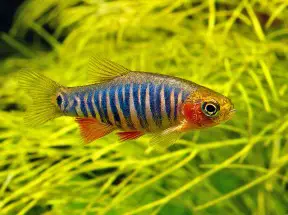
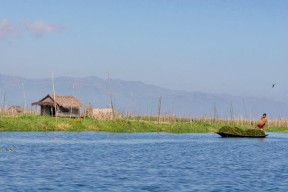

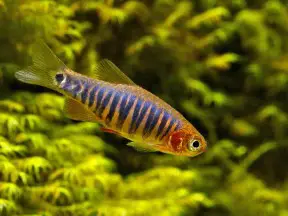
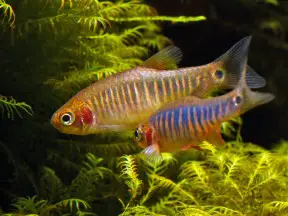
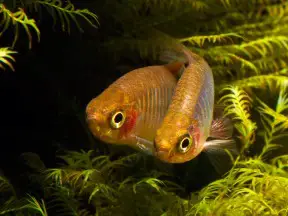
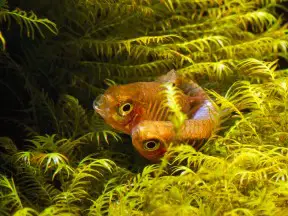
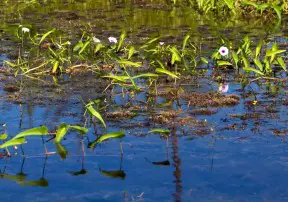
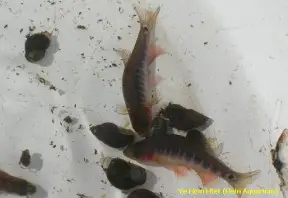

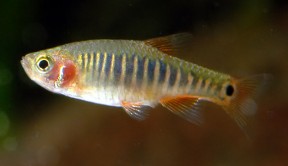
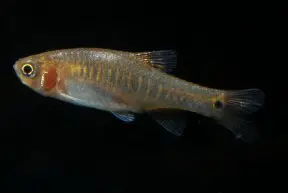
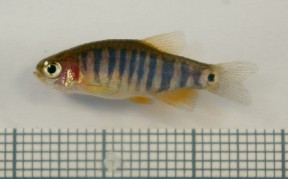

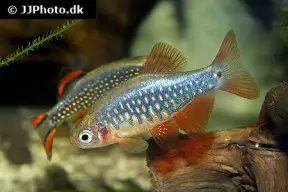
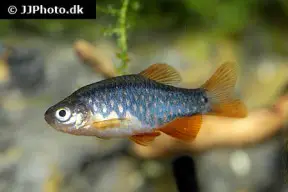
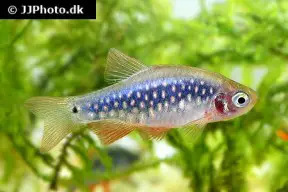

October 16th, 2012 at 11:33 pm
These are great little fish. I have a small shoal in my 10 gallon NPT along with a young female crowntail betta and a few baby shrimp. They are very active and curious yet skittish. They will dash for hiding when you walk by then slowly creep out if you sit there for awhile. Around feeding time, however, they become a fearless ferocious little swarm. They will steal food right out of the betta’s mouth.
Keeping lots of plants is definitely a good idea. They seem to color up better and act less skittish when they have a clump of plants to dash behind. My tank has drift wood and plenty of tannins from the garden soil substrate, but that doesn’t seem to be a problem for them at all.
All in all, these are a great and surprisingly easy fish to keep.
April 3rd, 2013 at 7:33 am
i have a 15 gallon planted tank with some bog with inside and no problems, 15 Erythronmicron 4 Celestial Pearl Danio. & they definetly behave the same way , true shoaler . very fun to watch ,